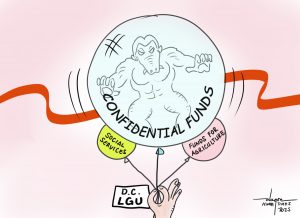 HERE is something that needs the immediate attention of the Davao City Engineer’s Office (CEO), or perhaps the Department of Public Works and Highways (DPWH), or the City Environment and Natural Resources Office (CENRO), whichever is the appropriate agency.
HERE is something that needs the immediate attention of the Davao City Engineer’s Office (CEO), or perhaps the Department of Public Works and Highways (DPWH), or the City Environment and Natural Resources Office (CENRO), whichever is the appropriate agency.
Yes, we feel it is urgent. Based on our personal observation, every time we go to the downtown of Davao City we take the route Magtuod-New Carmen-New Valencia-Talandang Road. We are happy that there is an ongoing expansion project on the road despite the snail-pace work of the contractor. In fact there were instances that we did not even see a single worker on the road expansion project. Whatever was or were the reasons we have no idea.
Anyhow, we have just to thank the government for expanding the width of the road considering that both sides of the route are ravines and the smaller its width the risk of vehicular accidents is high.
One other observation that we have and the one we are calling the attention of the CEO, the DPWH District Office, and perhaps more importantly, the CENRO, is the blatant abuse of some people who are into the business of buying and selling recyclable waste. They have been allocating to themselves some sections of the completed sides of the expanded road as their “stockyard.” In doing so, instead of the expansion being used by passing vehicles, the piles of recyclable waste placed inside huge sacks and dumped on the newly completed expansion are instead constricting the road.
We are encouraging the people in the concerned agencies whose job is to monitor road situations to lift their butts from their swivel chairs in their air-conditioned offices and go to the site we have mentioned here. We can be certain that what we have written about in this piece will be the same situation they will see when they come to inspect the place, more specifically the stretch between the Magtuod-New Carmen boundaries and the City Garbage Dump site.
Of course if the persons who are into the business of buying recyclables have the subtle approval of certain officials in the agencies we have mentioned. It is likely that whoever will be sent to inspect will find their eyes suddenly “blind” by the time they conduct their visit.
After all it cannot be denied that while trading reusable refuse is an unpleasant – even dirty – business, it is big money that the traders could use the said resource to influence certain decision makers from regulatory agencies.
***************************
Some columns back we took up the hottest issue of the day – the absence of a particular beverage product which is produced in a specific smaller size glass bottle. We asked what was going on in the company plant that may have hampered its production. We cannot help but suspect that something was wrong inside the plant – maybe it’s the machinery used in the bottling; or that the company could have been beset with labor problems. But what intrigued us the most is that if the problems we mentioned existed then the plant could not have continued its production of its product in bigger bottles.
It was only recently that our questions were answered in full. That was when the country’s leading beverage producers, mostly multinational companies, issued a joint statement claiming that their operation is affected adversely by the alleged lack of sugar which is an important component of their products. Their joint statement was some kind of a tacit support to the decision of certain officials in the Sugar Regulatory Administration (SRA) to import 300 thousand metric tons of sugar to compensate for the reported forthcoming shortage.
But there is something strange in that joint statement. How come only one softdrinks brand and bottle size disappeared from the stores and other outlets? The rest of the brands and bottle sizes are available. Then all of a sudden the other beverage bottlers suddenly joined in the pooled statement contending that they too are affected by the sugar lack.
Now we have this strong suspicion that there is a possible collusion among the soft drinks firms, the importers of sugar, and possibly some people in the SRA driven by “millions” of reasons.
Indeed, the sugar crisis, if we may call it that way, could be the President’s toughest test of his capability to govern and run the country. Yes, he has to do a very difficult balancing act. Will his final move in settling the problem be for the benefit of the importers and the huge commercial or industrial sugar users? Will it favor the sugar planters and millers? Or, will it favor the millions of ordinary Filipinos who are suffering from the ultra high prices of the commodity?
Indeed whatever will be adopted by the administration in handling this extremely difficult situation will eventually impact on the efforts of the government to resuscitate the country’s economy.
Will the moneyed influencers succeed in having their cause catered to by the President’s final decision? Or will it be the millions of Filipinos including the sugar industry workers who will be given favor? In the words of the late Sen. Landring Almendras, “Let us to see.”


